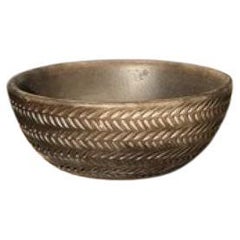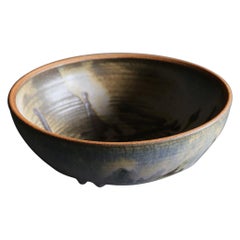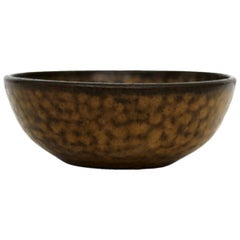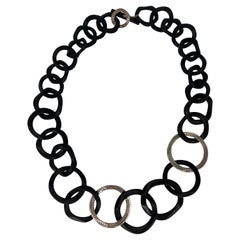John Hardy (Artist) Furniture
John Hardy was born in Tours, France, on March 23, 1923, to Charles Crum Hardy and the former Jacqueline Gadois. He lived in Brooklyn from age 1 to 6, when his family relocated to suburban Long Island. His mother died when he was 8, after which he was sent to live with another family in Roanoke, Va., while his father remained in New York. As a teenager, he lived with an aunt in Guilford, N.C He spent his childhood in various parts of the country including New York, Virginia, and North Carolina, and later lived in Florida and Georgia. His travels outside the USA include Europe, Greece, Egypt, Kenya, Uganda, the Caribbean Islands, Panama, and Mexico.
In 1942, he married Betty Blackman, with whom he lived for 26 years and raised four children. He served in the Army from 1940 to 1945, spending 16 months in Europe during World War II. At age 52, he moved to New York City with Page Ogden, to whom he was married for 12 years. He subsequently lived with Naomi Lionni, who died in 1992.
He taught drawing and painting from 1958 to 1981, first at the Atlanta College of Art, and subsequently at the College of Architecture at the Georgia Institute of Technology and at New York University. A figurative painter known especially for his portraits, cityscapes, and seascapes, his work captured the depth and complexity of his subjects with empathy, humor, and, in some cases, astute social commentary.
According to Gail Levin, an art historian, professor, and author specializing in the art of the 20th and 21st centuries, “Like those of [Edward] Hopper and [Reginald] Marsh, Hardy’s paintings often imply multi-layered meanings, enabling him to distill the essence of a cultural moment. . . . He selects and manipulates with an uncanny power, achieving ironic realism.”
John C. Hardy, an artist and teacher who lived in SoHo and Springs, died of complications from a stroke at Beth Israel Hospital in New York City on Oct. 10 2014 in the company of Joan Semmel, his companion for the past 21 years. He was 91.
Late 19th Century Italian Rustic Antique John Hardy (Artist) Furniture
Ceramic
21st Century and Contemporary American Organic Modern John Hardy (Artist) Furniture
Ceramic
1960s Dutch Mid-Century Modern Vintage John Hardy (Artist) Furniture
Ceramic
20th Century Japanese John Hardy (Artist) Furniture
Clay
Late 20th Century American John Hardy (Artist) Furniture
Ceramic
1950s Italian Mid-Century Modern Vintage John Hardy (Artist) Furniture
Clay, Ceramic
2010s American Aesthetic Movement John Hardy (Artist) Furniture
Ceramic
1940s Danish Vintage John Hardy (Artist) Furniture
Ceramic
21st Century and Contemporary American John Hardy (Artist) Furniture
Ceramic
1950s Vintage John Hardy (Artist) Furniture
Ceramic, Earthenware
Late 20th Century English Modern John Hardy (Artist) Furniture
Ceramic
21st Century and Contemporary American Organic Modern John Hardy (Artist) Furniture
Ceramic
1960s Unknown Mid-Century Modern Vintage John Hardy (Artist) Furniture
Ceramic
1950s American Mid-Century Modern Vintage John Hardy (Artist) Furniture
Paper
20th Century American John Hardy (Artist) Furniture
Sterling Silver
John Hardy (artist) furniture for sale on 1stDibs.
- 1stDibs ExpertApril 5, 2022No, John Hardy jewelry is not made in China. John Hardy jewelry was founded by the Canadian designer John Hardy, who began designing jewelry inspired by Indonesian culture. All John Hardy jewelry is made at the John Hardy compound in Bali, which was built in 1996. Shop a collection of John Hardy jewelry from reputable retailers, such as 1stDibs.
- 1stDibs ExpertOctober 7, 2024To tell if a John Hardy bracelet is real, familiarize yourself with the hallmarks that the Indonesian luxury jewelry maker has used over its more than 45-year history. You can find images of markings found on authentic pieces on trusted online resources. Compare the pictures to your jewelry, looking for any irregularities in the spelling, positioning and wording that may indicate your piece is counterfeit. Also, check the bracelet carefully for flaws, such as variations in the finish or poorly functioning clasps. Genuine John Hardy pieces are usually free of these types of defects due to the jewelry maker's rigorous quality standards. If you're still unsure whether your piece is real, a certified appraiser or knowledgeable jeweler can assist you. Find a diverse assortment of John Hardy bracelets on 1stDibs.
- 1stDibs ExpertOctober 15, 2024To tell if John Hardy jewelry is authentic, look for a maker's mark, usually found in an inconspicuous area, such as on the clasp of a necklace or the inside of a bracelet. Early pieces typically feature a “JH” logo along with a metal hallmark, while later ones usually bear the full “John Hardy” name alongside a metal hallmark. You can find photographs of markings on authentic pieces on trusted online resources to compare to your piece. If you notice any discrepancies, your jewelry may be a replica. For further assistance with authentication, consider consulting a certified appraiser or knowledgeable jeweler. On 1stDibs, explore an assortment of John Hardy jewelry.




